Performance of Catalytic Fast Pyrolysis Using a γ-Al2O3 Catalyst with Compound Modification of ZrO2 and CeO2
Abstract
1. Introduction
2. Results and Discussion
2.1. Characteristics of the Catalysts
2.1.1. Characterization of the Adsorption–Desorption of N2
2.1.2. Characterization of NH3-TPD
2.2. Effect of the Catalyst on Pyrolysis
2.2.1. Effect of Catalyst on the Relative Content of Pyrolysis Products

2.2.2. Catalytic Effect on Distribution of Pyrolysis Products
Catalytic Effect on Phenols
Catalytic Effect on Acids
Catalytic Effect on Ketones
Catalytic Effects on Furans
Catalytic Effect on Hydrocarbons
Catalytic Effect on Other Compounds

3. Experimental
3.1. Materials
3.2. Preparation of Catalysts
3.3. Characterization of the Catalysts
3.4. Experimental Methods
3.4.1. Catalytic Pyrolysis Experimental Apparatus and Method
3.4.2. Calculation of Relative Content of Product Components
4. Conclusions
Author Contributions
Funding
Conflicts of Interest
References
- Neves, D.; Thunman, H.; Matos, A.; Tarelho, L.; Gomez-Barea, A. Characterization and prediction of biomass pyrolysis products. Prog. Energy Combust. Sci. 2011, 37, 611–630. [Google Scholar] [CrossRef]
- Czernik, S.; Bridgwater, A.V. Overview of applications of biomass fast pyrolysis oil. Energy Fuels 2004, 18, 590–598. [Google Scholar] [CrossRef]
- Liu, C.J.; Wang, H.M.; Karim, A.M.; Sun, J.M.; Wang, Y. Catalytic fast pyrolysis of lignocellulosic biomass. Chem. Soc. Rev. 2014, 43, 7594–7623. [Google Scholar] [CrossRef] [PubMed]
- Zhang, B.; Zhong, Z.P.; Min, M.; Ding, K.; Xie, Q.L.; Ruan, R. Catalytic fast co-pyrolysis of biomass and food waste to produce aromatics: Analytical Py-GC/MS study. Bioresour. Technol. 2015, 189, 30–35. [Google Scholar] [CrossRef] [PubMed]
- Zhang, Y.D.; Chen, P.; Lou, H. In situ catalytic conversion of biomass fast pyrolysis vapors on HZSM-5. J. Energy Chem. 2016, 25, 427–433. [Google Scholar] [CrossRef]
- Adjaye, J.D.; Katikaneni, S.P.R.; Bakhshi, N.N. Catalytic conversion of a biofuel to hydrocarbons: Effect of mixtures of HZSM-5 and silica-alumina catalysts on product distribution. Fuel Process. Technol. 1996, 48, 115–143. [Google Scholar] [CrossRef]
- Williams, P.T.; Horne, P.A. The influence of catalyst regeneration on the composition of zeolite-upgraded biomass pyrolysis oils. Fuel 1995, 74, 1839–1851. [Google Scholar] [CrossRef]
- Mihalcik, D.J.; Mullen, C.A.; Boateng, A.A. Screening acidic zeolites for catalytic fast pyrolysis of biomass and its components. J. Anal. Appl. Pyrolysis 2011, 92, 224–232. [Google Scholar] [CrossRef]
- Mochizuki, T.; Atong, D.; Chen, S.Y.; Toba, M.; Yoshimura, Y. Effect of SiO2 pore size on catalytic fast pyrolysis of Jatropha, residues by using pyrolyzer-GC/MS. Catal. Commun. 2013, 36, 1–4. [Google Scholar] [CrossRef]
- Bjorgen, M.; Olsbye, U.; Kolboe, S. Coke precursor formation and zeolite deactivation: Mechanistic insights from hexamethylbenzene conversion. J. Catal. 2003, 215, 30–44. [Google Scholar] [CrossRef]
- Kelkar, S.; Saffron, C.M.; Li, Z.L.; Kim, S.S.; Pinnavaia, T.J.; Miller, D.J.; Kriegel, R. Aromatics from biomass pyrolysis vapour using a bifunctional mesoporous catalyst. Green Chem. 2014, 16, 803–812. [Google Scholar] [CrossRef]
- Ying, J.Y.; Mehnert, C.P.; Wong, M.S. Synthesis and applications of supramolecular-templated mesoporous materials. Angew. Chem. Int. Ed. 1999, 38, 56–77. [Google Scholar] [CrossRef]
- Lu, Q.; Zhansg, Y.; Tang, Z.; Li, W.Z.; Zhu, X.F. Catalytic upgrading of biomass fast pyrolysis vapors with titania and zirconia/titania based catalysts. Fuel 2010, 89, 2096–2103. [Google Scholar] [CrossRef]
- Loviat, F.; Czekaj, I.; Wambach, J.; Wokaun, A. Nickel deposition on γ-Al2O3 model catalysts: An experimental and theoretical investigation. Surf. Sci. 2009, 603, 2210–2217. [Google Scholar] [CrossRef]
- Krár, M.; Kovács, S.; Kalló, D.; Hancsok, J. Fuel purpose hydrotreating of sunflower oil on Co Mo/Al2O3 catalyst. Bioresour. Technol. 2010, 101, 9287–9293. [Google Scholar] [CrossRef] [PubMed]
- Zheng, Y.; Chen, D.Y.; Zhu, X.F. Aromatic hydrocarbon production by the online catalytic cracking of lignin fast pyrolysis vapors using Mo2N/γ-Al2O3. J. Anal. Appl. Pyrolysis 2013, 104, 514–520. [Google Scholar] [CrossRef]
- Tanabea, K.; Yamaguchib, T. Acid-base bifunctional catalysis by ZrO2 and its mixed oxides. Catal. Today 1994, 20, 185–197. [Google Scholar] [CrossRef]
- Rezaei, M.; Alavi, S.M.; Sahebdelfar, S.; Yan, Z.F.; Teunissen, H.; Jacobsen, J.H.; Sehested, J. Synthesis of pure tetragonal zirconium oxide with high surface area. J. Mater. Sci. 2007, 42, 1228–1237. [Google Scholar] [CrossRef]
- Dominguez, J.M.; Hernandez, J.L.; Sandoval, G. Surface and catalytic properties of Al2O3–ZrO2, solid solutions prepared by sol–gel methods. Appl. Catal. A-Gen. 2000, 197, 119–130. [Google Scholar] [CrossRef]
- Liu, P.J.; Wei, H.Z.; He, S.B.; Sun, C.L. Catalytic wet peroxide oxidation of m-cresol over Fe/gamma-Al2O3 and Fe-Ce/gamma-Al2O3. Chem. Pap. 2015, 69, 827–838. [Google Scholar] [CrossRef]
- Jongsomjit, B.; Panpranot, J.; Goodwin, J.G. Effect of zirconia-modified alumina on the properties of Co/γ-Al2O3 catalysts. J. Catal. 2003, 215, 66–77. [Google Scholar] [CrossRef]
- Guzman, J.; Carrettin, S.; Corma, A. Spectroscopic evidence for the supply of reactive oxygen during CO oxidation catalyzed by gold supported on nanocrystalline CeO2. J. Am. Chem. Soc. 2005, 127, 3286–3287. [Google Scholar] [CrossRef] [PubMed]
- Damyanova, S.; Pawelec, B.; Arishtirova, K.; Huerta, M.V.M.; Fierro, J.L.G. Study of the surface and redox properties of ceria–zirconia oxides. Appl. Catal. A-Gen. 2008, 337, 86–96. [Google Scholar] [CrossRef]
- Culberson, C.F. Improved conditions and new data for the identification of lichen products by a standardized thin-layer chromatographic method. J. Chromatogr. A 1972, 72, 113–125. [Google Scholar] [CrossRef]
- Tsai, W.T.; Lee, M.K.; Chang, J.H.; Su, T.Y.; Chang, Y.M. Characterization of bio-oil from induction-heating pyrolysis of food-processing sewage sludges using chromatographic analysis. Bioresour. Technol. 2009, 100, 2650–2654. [Google Scholar] [CrossRef]
- Adam, J.; Blazsó, M.; Mészáros, E.; Stocker, M.; Nilsen, M.H.; Bouzga, A.; Hustad, J.E.; Gronli, M.; Oye, G. Pyrolysis of biomass in the presence of Al-MCM-41 type catalysts. Fuel 2015, 8, 1494–1502. [Google Scholar] [CrossRef]
- Wang, W.L.; Li, X.P.; Ye, D.; Cai, L.P.; Sheldon, Q. Catalytic pyrolysis of larch sawdust for phenol-rich bio-oil using different catalysts. Renew. Energy 2018, 270, 529–536. [Google Scholar] [CrossRef]
- An, Y.; Tahmasebi, A.; Yu, J.L. Mechanism of synergy effect during microwave co-pyrolysis of biomass and lignite. J. Anal. Appl. Pyrolysis 2017, 128, 75–82. [Google Scholar] [CrossRef]
- Li, Z.H.; Bi, Z.H.; Yan, L.F. Two-step hydrogen transfer catalysis conversion of lignin to valuable small molecular compounds. Green Process. Synth. 2017, 4, 363–370. [Google Scholar] [CrossRef]
- Kurnia, I.; Karnjanakom, S.; Bayu, A.; Yoshida, A.; Rizkiana, J.; Prakoso, T.; Abudula, A.; Guan, G.Q. In-situ catalytic upgrading of bio-oil derived from fast pyrolysis of lignin over high aluminum zeolites. Fuel Process. Technol. 2017, 167, 730–737. [Google Scholar] [CrossRef]
- Bridgwater, A.V. Review of fast pyrolysis of biomass and product upgrading. Biomass Bioenergy 2012, 38, 68–94. [Google Scholar] [CrossRef]
- Lee, S.; Lee, M.-G.; Park, J. Catalytic upgrading pyrolysis of pine sawdust for bio-oil with metal oxides. J. Mater. Cycles Waste Manag. 2018, 20, 1553–1561. [Google Scholar] [CrossRef]
- Lu, Q.; Zhang, J.; Zhu, X. Corrosion properties of bio-oil and its emulsions with diesel. Chin. Sci. Bull. 2008, 53, 3726–3734. [Google Scholar] [CrossRef]
- Pattiya, A.; Titiloye, J.O.; Bridgwater, A.V. Fast pyrolysis of cassava rhizome in the presence of catalysts. J. Anal. Appl. Pyrolysis 2008, 81, 72–79. [Google Scholar] [CrossRef]
- Lu, Q.; Li, W.-Z.; Zhang, D.; Zhu, X.-F. Analytical pyrolysis-gas chromatography/mass spectrometry (Py-GC/MS) of sawdust with Al/SBA-15 catalysts. J. Anal. Appl. Pyrolysis 2009, 84, 131–138. [Google Scholar]
- Witsuthammakul, A.; Sooknoi, T. Selective hydrodeoxygenation of bio-oil derived products: Ketones to olefins. Catal. Sci. Technol. 2015, 5, 3639–3648. [Google Scholar] [CrossRef]
- Tong, X.; Ma, Y.; Li, Y. Biomass into chemicals: Conversion of sugars to furan derivatives by catalytic processes. Appl. Catal. A-Gen. 2010, 385, 1–13. [Google Scholar] [CrossRef]
- Meier, D.; Faix, O. State of the art of applied fast pyrolysis of lignocellulosic materials—A review. Bioresour. Technol. 1999, 68, 71–77. [Google Scholar] [CrossRef]
- Wang, J.; Zhang, B.; Zhong, Z.P.; Ding, K.; Deng, A.D.; Min, M.; Min, M.; Ruan, R. Catalytic fast co-pyrolysis of bamboo residual and waste lubricating oil over an ex-situ dual catalytic beds of MgO and HZSM-5: Analytical PY-GC/MS study. Energy Convers. Manag. 2017, 139, 222–231. [Google Scholar] [CrossRef]
- Kaewpengkrow, P.; Atong, D.; Sricharoenchaikul, V. Catalytic upgrading of pyrolysis vapors from Jatropha wastes using alumina, zirconia and titania based catalysts. Bioresour. Technol. 2014, 163, 262–269. [Google Scholar] [CrossRef]
- Mui, E.L.K.; Cheung, W.H.; Lee, V.K.C.; McKay, G. Compensation effect during the pyrolysis of tyres and bamboo. Waste Manag. 2010, 30, 821–830. [Google Scholar] [CrossRef] [PubMed]
- Lou, R.; Wu, S.B.; Lv, G.J. Effect of conditions on fast pyrolysis of bamboo lignin. J. Anal. Appl. Pyrolysis 2010, 89, 191–196. [Google Scholar] [CrossRef]
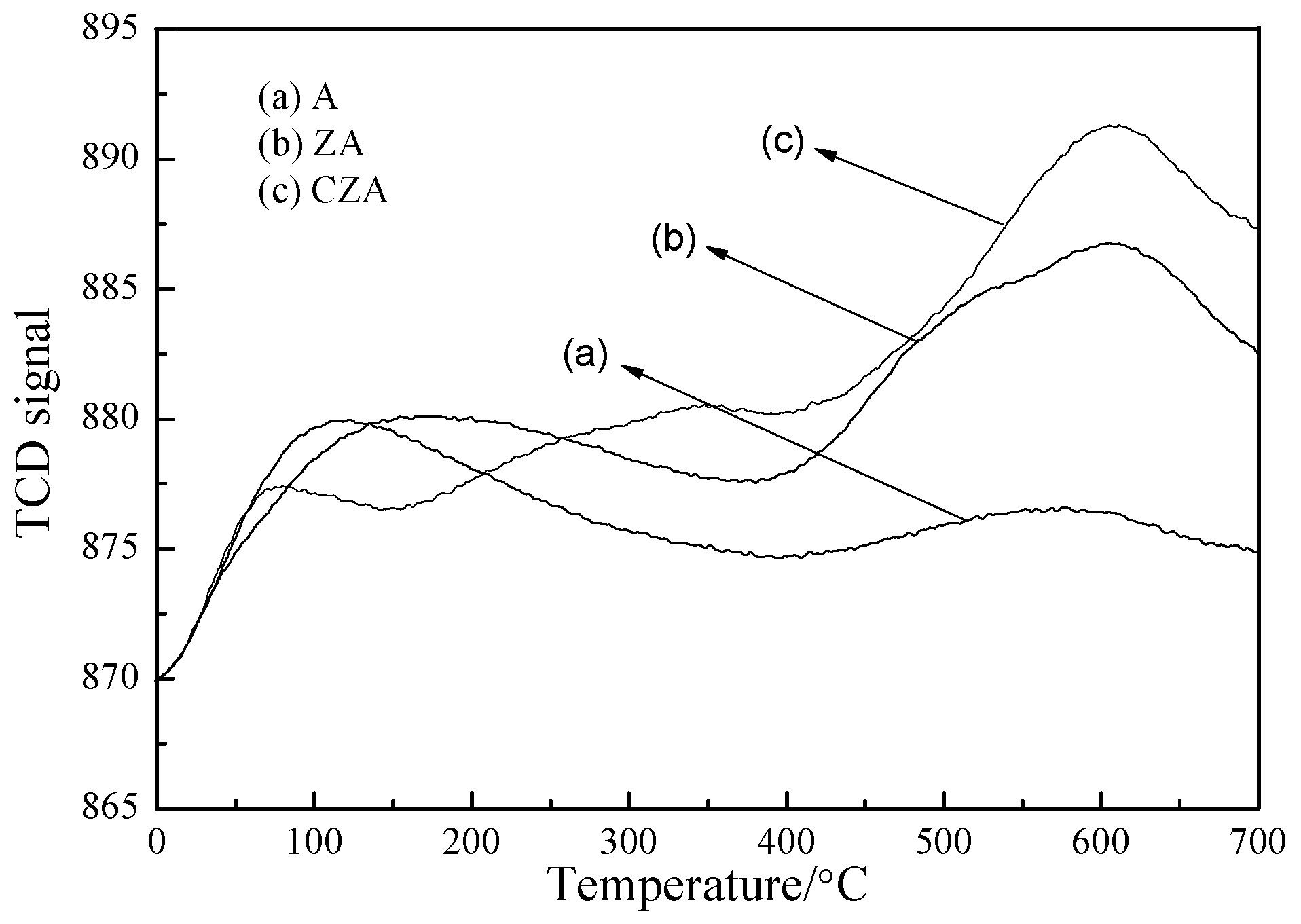
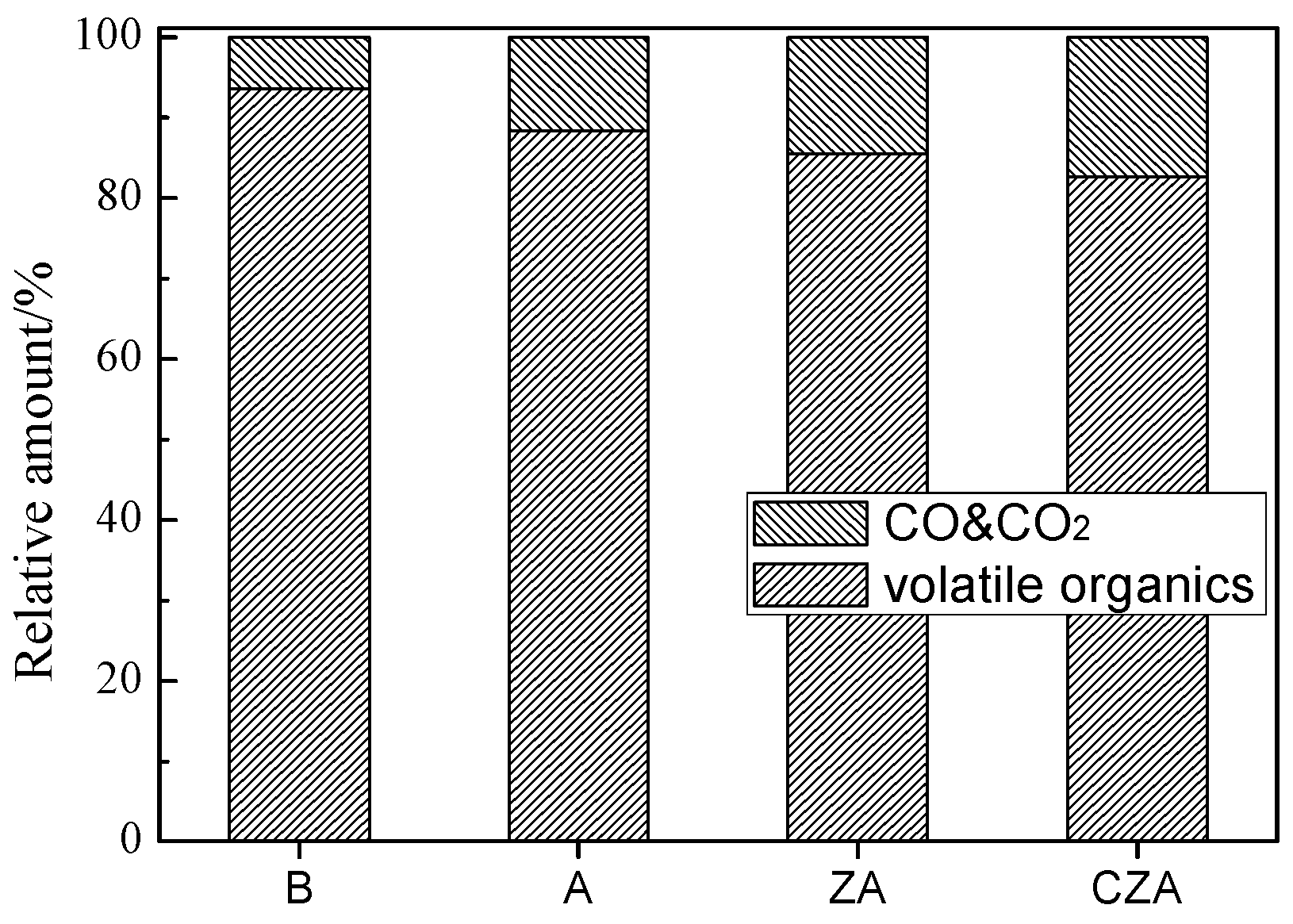


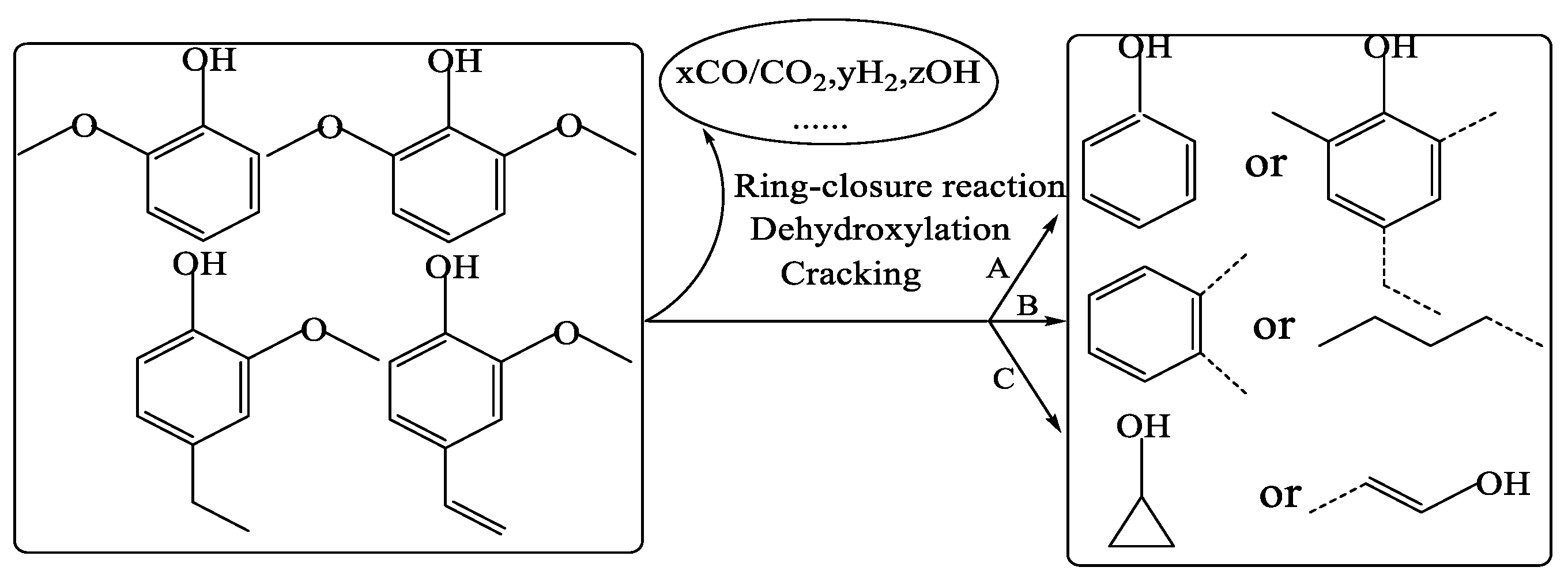
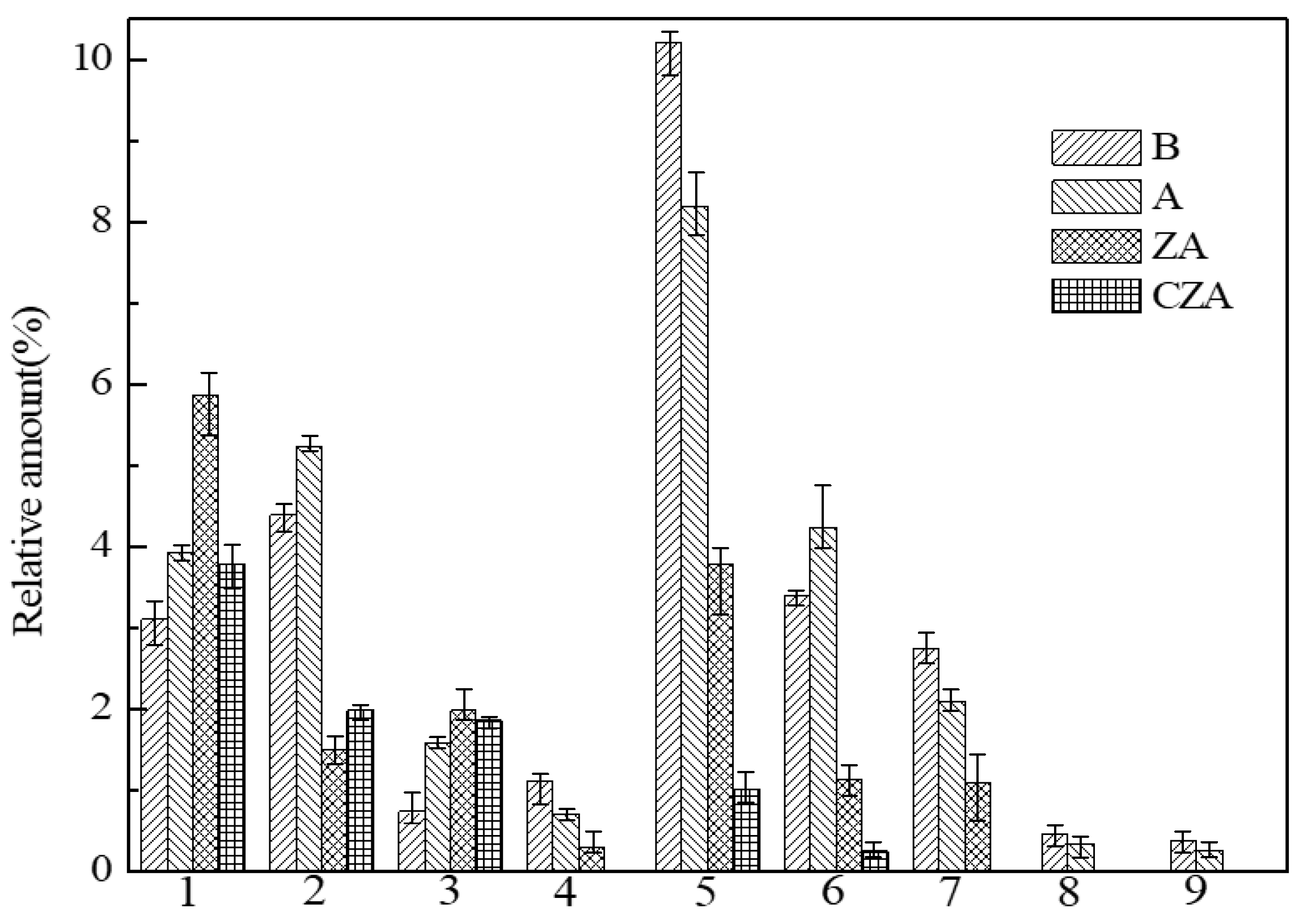

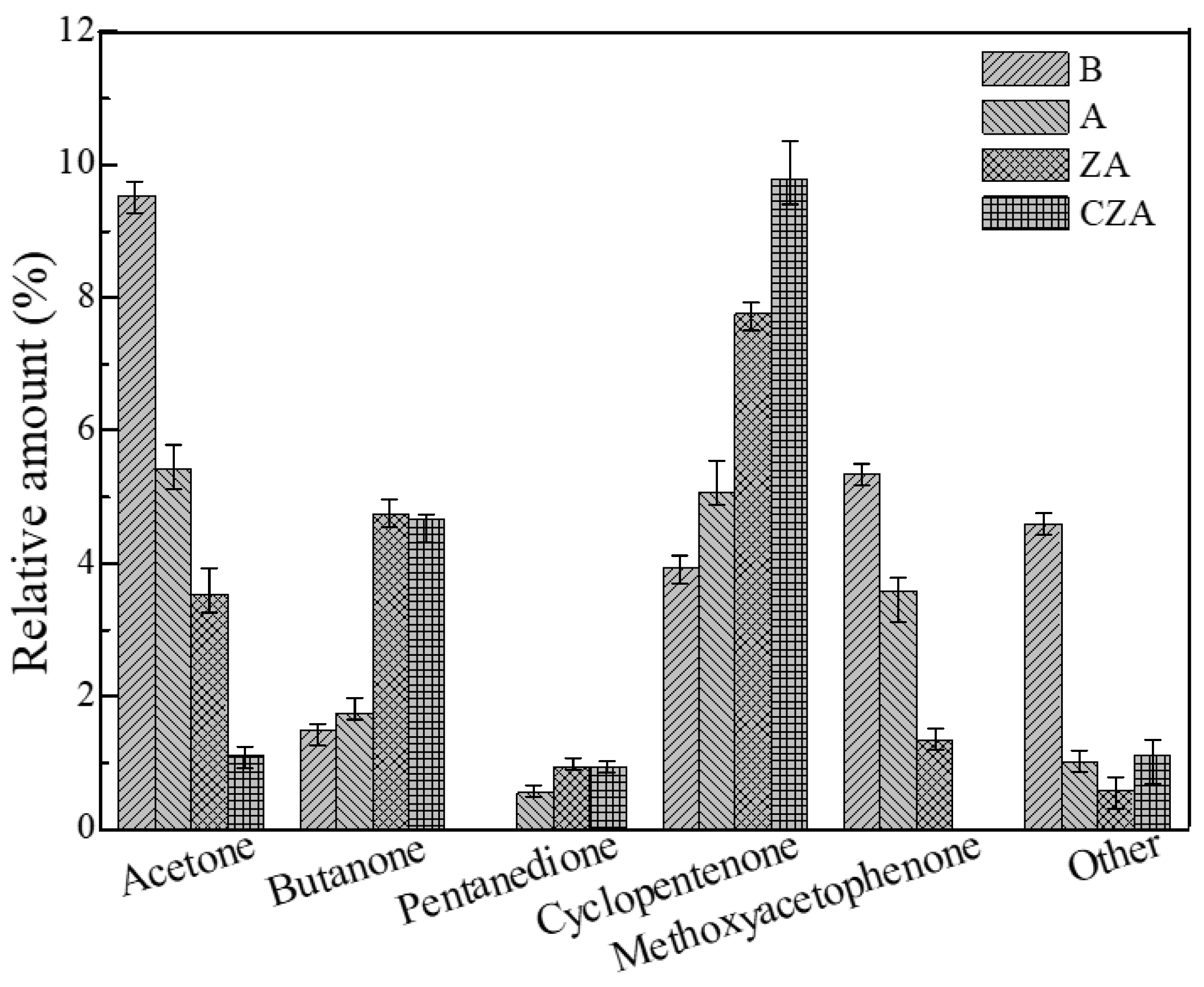

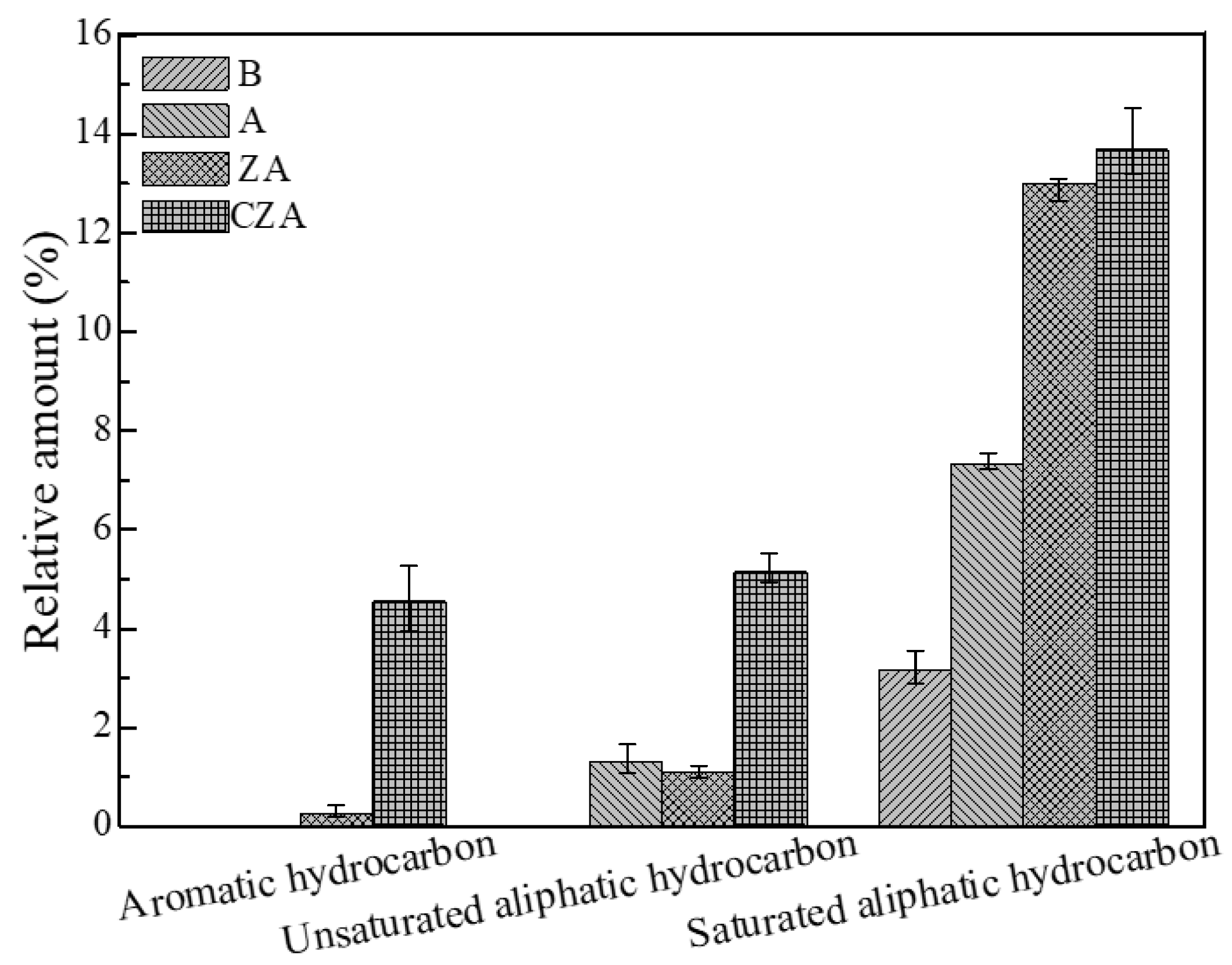
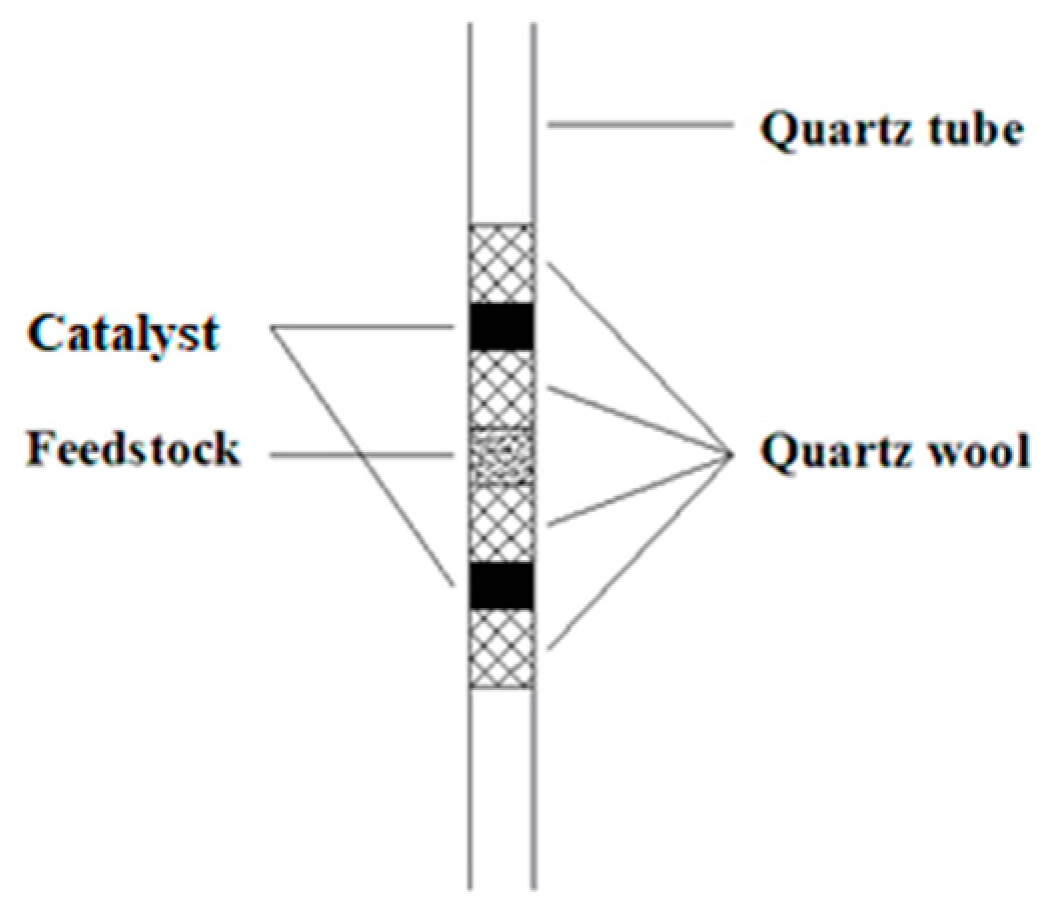
| Catalyst | Specific Surface Area (m2/g) | Pore Volume (cm3/g) | Average Pore Width (nm) |
|---|---|---|---|
| A | 162.1 | 0.45 | 11.17 |
| ZA | 206.8 | 0.52 | 10.09 |
| CZA | 177.1 | 0.54 | 12.12 |
| Ultimate Analysis | C | H | O | N | S |
|---|---|---|---|---|---|
| Bamboo residue | 51.51 | 6.12 | 42.05 | 0.21 | 0.11 |
© 2019 by the authors. Licensee MDPI, Basel, Switzerland. This article is an open access article distributed under the terms and conditions of the Creative Commons Attribution (CC BY) license (http://creativecommons.org/licenses/by/4.0/).
Share and Cite
Xue, Z.; Zhong, Z.; Zhang, B.; Xu, C. Performance of Catalytic Fast Pyrolysis Using a γ-Al2O3 Catalyst with Compound Modification of ZrO2 and CeO2. Catalysts 2019, 9, 849. https://doi.org/10.3390/catal9100849
Xue Z, Zhong Z, Zhang B, Xu C. Performance of Catalytic Fast Pyrolysis Using a γ-Al2O3 Catalyst with Compound Modification of ZrO2 and CeO2. Catalysts. 2019; 9(10):849. https://doi.org/10.3390/catal9100849
Chicago/Turabian StyleXue, Zeyu, Zhaoping Zhong, Bo Zhang, and Chao Xu. 2019. "Performance of Catalytic Fast Pyrolysis Using a γ-Al2O3 Catalyst with Compound Modification of ZrO2 and CeO2" Catalysts 9, no. 10: 849. https://doi.org/10.3390/catal9100849
APA StyleXue, Z., Zhong, Z., Zhang, B., & Xu, C. (2019). Performance of Catalytic Fast Pyrolysis Using a γ-Al2O3 Catalyst with Compound Modification of ZrO2 and CeO2. Catalysts, 9(10), 849. https://doi.org/10.3390/catal9100849






